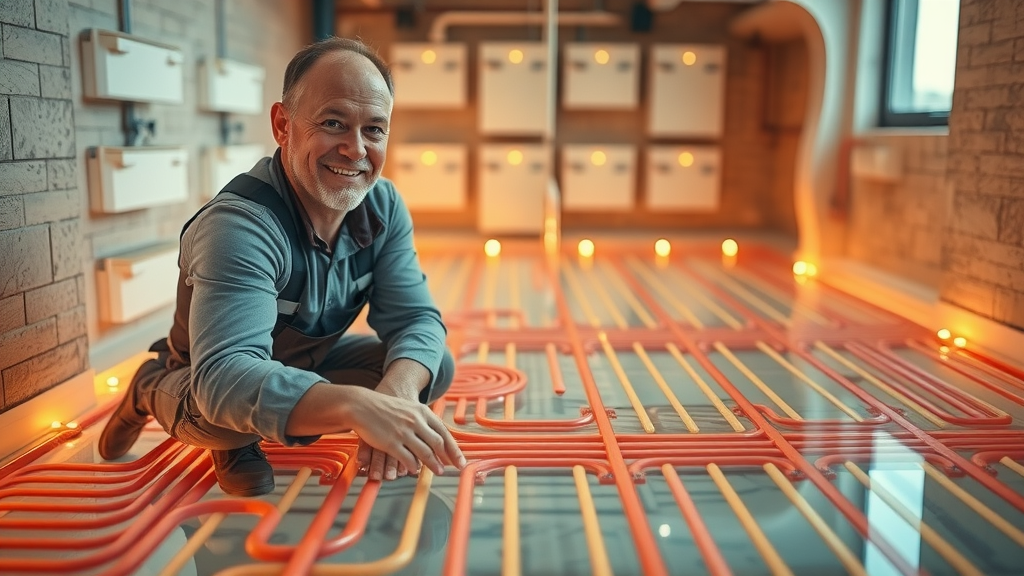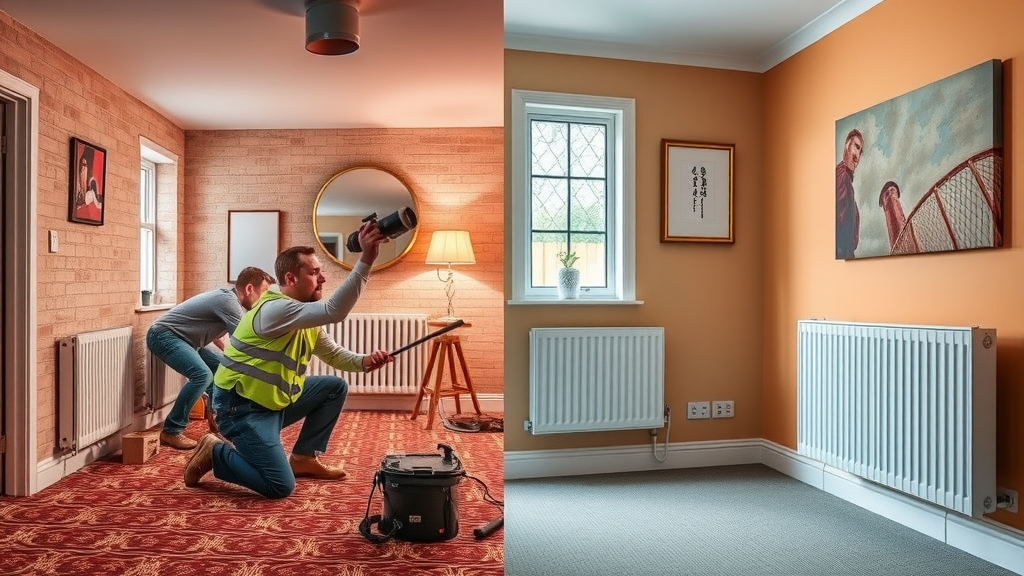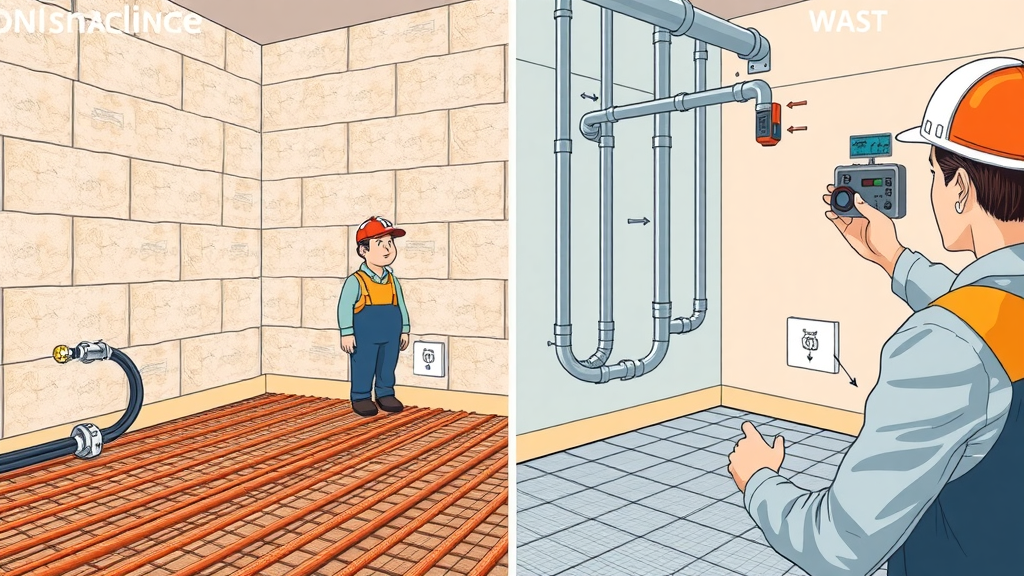Are traditional radiators a thing of the past? If you've ever wondered whether your home heating system is keeping up with modern standards—or if there’s a better option—you’re not alone. Across the UK, homeowners are rethinking their approach and weighing underfloor heating vs. radiators when comfort, energy efficiency, and value matter most. In this comprehensive guide, you'll discover which heating system wins out for cost, comfort, and efficiency—and how you can futureproof your property.
Opening Inquiry: Are Radiators Outdated? Challenging Tradition in Modern Heating Systems
For decades, radiators have been the standard in UK homes, often chosen for their reliability and straightforward installation. Yet, the rise of new heating systems—especially underfloor heating—has led many to ask: are radiators outdated? As our homes become more efficient and open-plan, the drawbacks of traditional radiator systems are coming to light. Homeowners are noticing uneven heat, wasted wall space, and mounting energy bills. Meanwhile, underfloor heating is gaining traction, promising even warmth, improved air quality, and modern design flexibility. Throughout this article, you'll see how these two approaches stack up and why more people are choosing to leave radiators behind.

What You’ll Learn: Comparing Underfloor Heating vs. Radiators for Residential Comfort and Value
- The fundamental differences between underfloor heating and radiator systems
- How each heating system performs in terms of energy efficiency, cost, and installation
- The long-term benefits and potential pitfalls of underfloor heating vs. radiators
- Key factors to consider when choosing the right heating system for your home
- How working with a professional heating engineer can guarantee optimal results
Understanding the Basics: What Is Underfloor Heating vs. Radiators?
How Underfloor Heating Systems Work: The Science Behind Even Warmth
Underfloor heating systems use a network of pipes or electric cables installed beneath your floor to gently warm your living space from the ground up. Unlike radiator systems, which heat air from a single point and often create uncomfortable cold spots, underfloor heating distributes warmth evenly. This radiant heat moves consistently, maintaining a comfortable, low temperature throughout the room. Water-based underfloor heating (wet systems) circulate warm water using your existing boiler or heat pump, while electric underfloor heating employs heated wires for instant comfort in smaller zones. The science is simple: by covering a larger surface area at a lower temperature, these systems reduce heat loss and often require less energy to create the same feeling of warmth—making them considerably more efficient than radiators found in most homes.
When you step into a room warmed by underfloor heating, you immediately notice the difference: even temperatures, no drafts, and the delight of warm floors underfoot. This consistency translates to lower running costs and greater energy efficiency, as the heating system can operate at a lower flow temperature. Working with a certified heating engineer ensures everything is properly balanced and optimized for your home’s insulation, floor type, and overall design, especially vital in both new build and retrofit projects.

Traditional Radiator Systems Explained: Conventional Heating, Modern Limitations
Traditional radiator systems rely on heated water or electric elements inside metal panels placed along your walls. These hot panels warm the air in the immediate vicinity, causing heat to rise toward the ceiling and slowly circulate around the room. While effective, this process is less efficient than modern alternatives, leading to hot spots near radiators and persistent cold zones across the floor. In open-plan or larger rooms, that often means inconsistent comfort and higher energy bills as you overcompensate to push warmth into every corner. Older radiator systems typically run at higher temperatures, which increases heat loss and lowers overall energy efficiency compared to underfloor heating systems that use lower, more stable temperatures.
Another drawback is practicality: bulky radiators take up valuable wall space and limit interior design flexibility. They also attract dust, can interfere with furniture placement, and generally fall short in delivering the kind of control and aesthetics that modern homeowners expect. As energy prices rise and sustainable living takes centre stage, many are questioning whether traditional radiators remain the best choice when options like underfloor heating promise so much more.
Heating System Installation Costs: Underfloor Heating vs. Radiator Systems
Installation Cost Breakdown: Underfloor Heating System vs. Radiator System
The installation cost is a crucial consideration when choosing between underfloor heating and radiators. Radiator systems usually have lower upfront costs, especially in new builds where basic radiators are easily installed during construction. Alternatively, adding radiators during a retrofit is also relatively straightforward and quick—making it appealing for homeowners on a tight budget.
However, installing underfloor heating—particularly in an existing home with finished floors—often means greater complexity and a higher initial outlay. The project may include lifting floors, upgrading insulation, and integrating controls, all which add to the installation costs. Yet, this investment can significantly pay off over time thanks to better energy efficiency, improved thermostatic control, and increased property value. For new builds, the difference in installation cost can be much smaller, as the system is easily included in the building process. Working with an expert heating engineer ensures accurate system design and smooth installation, ultimately avoiding costly mistakes or inefficiencies down the line.
Factors That Affect Installation Costs (New Build vs. Retrofit, Floor Types, Room Size)
Installation costs vary depending on whether the system is fitted during a new build or a retrofit. New builds allow easier planning and can incorporate underfloor heating seamlessly, often costing less per square metre than in retrofitting scenarios where existing floors must be removed. Floor types, such as tiles or hardwood, also influence the budget—tiles conduct heat better, making them ideal for efficient heating, while thick carpets or laminate may require extra consideration.
Room size and layout are critical. Larger, open-plan rooms benefit most from underfloor heating’s consistent warmth, while small spaces may see minimal cost differences with radiators. Other factors impacting cost include the presence of multiple floors, the complexity of your heating zones, and the choice between electric underfloor and water-based systems. A professional assessment by a certified heating engineer helps identify the best approach, whether you’re designing a new build or upgrading an existing floor plan.
| System Type | Average Installation Cost (New Build, per m²) | Average Installation Cost (Retrofit, per m²) | Key Notes |
|---|---|---|---|
| Wet Underfloor Heating | £90–£130 | £120–£180 | Best for new builds; retrofit adds flooring/labour |
| Electric Underfloor Heating | £60–£100 | £80–£130 | Faster install, ideal for single rooms |
| Radiator System | £50–£70 | £70–£90 | Minimal disruption; limited by wall space |

Heating System Running Costs: Energy Efficiency and Monthly Bills
Energy Efficiency Explained: Underfloor Heating and Radiators Compared
Energy efficiency is one of the biggest advantages when comparing underfloor heating vs. radiators. Underfloor heating systems require lower water or operating temperatures (often as little as 35–45°C compared to 60–75°C for traditional radiator systems) and achieve the same heating effect due to their much larger surface area. The result? Less heat loss and lower monthly energy bills. When paired with high-efficiency boilers or heat pumps, underfloor heating becomes even more cost-effective and environmentally friendly.
In contrast, radiator systems often work harder and longer to maintain comfortable temperatures, burning more fuel and increasing your running costs. Additionally, radiators do not distribute heat as evenly—often leading to wasted energy as you compensate for persistent cold spots. Homeowners who switch to underfloor heating consistently report both improved comfort and tangible savings on their energy bills, especially when combined with efficient insulation and modern smart controls.

Running Costs: Long-Term Savings with Underfloor Heating vs. Radiators
Looking at your home’s future, the monthly running cost of underfloor heating is generally lower than that of radiator systems. Because underfloor heating operates more efficiently at lower temperatures, it makes the most of every kilowatt-hour—translating to less energy waste and longer-term financial savings.
It’s worth noting, however, that electric underfloor heating can be more expensive to run in large spaces than water-based systems due to the higher price of electricity compared to gas. Still, for smaller rooms, bathrooms, or selective heating zones, electric systems can offer cost-effective and rapid installation solutions.
| System Type | Estimated Monthly Cost (3-bed home) | Average Annual Saving vs. Radiator |
|---|---|---|
| Wet Underfloor Heating (Gas) | £55–£70 | £80–£180 |
| Electric Underfloor Heating | £85–£120 | £0–£60 |
| Traditional Radiators (Gas) | £70–£95 | — |
Comfort Levels: Consistency, Control, and Living Experience
Low Temperature Radiant Heat: Healthier and More Consistent Room Temperatures
One of underfloor heating’s greatest strengths is consistent, low temperature radiant heat. With the entire floor acting as one large, gentle heat source, you avoid the uncomfortable drafts and hot-air “pockets” typical of radiator-based systems. This stability is especially noticeable in open-plan or high-ceiling homes, where traditional radiators might struggle to distribute warmth evenly. The result is better personal comfort and a healthier living environment—dust circulation is reduced, air is less dry, and allergens are kept at bay.
Moreover, radiant floor systems work incredibly well with modern energy-efficient materials and improved insulation standards, supporting better overall health and wellbeing compared with conventional radiator systems. As energy prices fluctuate, maintaining comfort at a lower temperature further shields you from spikes in energy bills, and the comfort level experienced is often described as “luxurious” by those who have made the switch.
Room-by-Room Control: Zoning with Underfloor Heating vs. Radiators
Underfloor heating systems allow you to set individual temperatures for each room or zone in your home—providing personalised comfort and saving energy. Zoning means you can heat only the rooms you use, when you use them, without wasting heat elsewhere. Radiators can be fitted with thermostatic valves for some level of control, but this remains rudimentary compared to the flexibility and smart-home integration of modern underfloor heating. For busy households or multi-use spaces—such as home offices and bedrooms—zoning is a major game-changer.
- No Cold Spots: Full floor coverage means there’s consistent warmth across the space, eliminating the classic hot-and-cold patchwork effect of radiators.
- Improved Air Quality: Reduced convection means less dust and allergen movement, great for allergy sufferers or anyone prioritising healthy living.
- Discreet Aesthetics: Underfloor systems are completely hidden, freeing up wall space and supporting a modern, uncluttered design approach.

Design and Practicality: The Interior Impact of Underfloor Heating and Radiators
Space Saving and Interior Flexibility
When it comes to interior design, underfloor heating offers a clear advantage by freeing up precious wall space once taken by bulky radiators. With no visible pipes or panels, you gain complete flexibility over furniture placement, wall finishes, and room layouts—ideal for open-plan spaces, minimalistic interiors, or busy family homes. The absence of radiators not only elevates aesthetic appeal but also makes cleaning, decorating, and remodelling much simpler. As a result, underfloor heating supports more creative and adaptable living spaces than any traditional radiator system can provide.
Homeowners increasingly recognise the benefit of maximising “useable” space, especially as properties shrink in size or convert existing rooms for multiple uses. For retrofits and new builds alike, underfloor heating systems enable more inspiring environments—making the most of every square metre.

Underfloor Heating for New Builds and Retrofits
One of the most common misconceptions is that underfloor heating is only suitable for new builds. While installation is simpler in properties under construction, advances in systems and materials mean retrofitting is more viable than ever—even for older homes with existing floors. “Overlay” systems keep floor-raising to a minimum, and rapid-drying screeds help streamline project timescales. That said, a detailed appraisal by a specialist heating engineer is always advised to ensure the right system and design approach for your building.
For those embarking on a new build project, integrating underfloor heating at the planning stage delivers the greatest value, allowing you to optimise insulation, smart controls, and efficient energy usage from day one. This is where collaboration with experienced professionals, like Peak Underfloor Heating Ltd, can make all the difference.
"Underfloor heating isn’t just a luxury—it’s practical efficiency that redefines living spaces. – Peak Underfloor Heating Ltd Consultant"
Electric vs. Water Underfloor Heating: Which System Suits Your Home?
Installing Electric Underfloor Heating: Pros, Cons, and Cost
Electric underfloor heating uses flexible mats or cables that are installed just beneath the floor covering. Installation is typically faster and less disruptive than wet systems, making it perfect for bathrooms, kitchens, and small individual rooms, as well as for retrofitting. Upfront costs for materials and fitting are generally lower, and DIY-friendly kits are widely available for confident homeowners. The major drawback? Higher running costs compared to water-based systems, due to the increased price of electricity in the UK. As a result, electric underfloor heating is best suited for occasional-use spaces or small, targeted zones rather than heating an entire home.
Still, the comfort, rapid response times, and minimal floor height increase make electric underfloor systems a compelling option for those upgrading a single room or wanting underfloor warmth with minimal disruption. To ensure safe installation and compliance with regulations, enlisting a certified heating engineer is strongly recommended—especially for zones with wet-room requirements.
Water (Wet) Underfloor Heating Systems: Efficiency and Application
Water underfloor heating systems (often called “wet” systems) circulate warm water from your boiler or a renewable heat source through pipes embedded beneath the floor. These systems have the lowest ongoing running costs and integrate seamlessly with gas boilers, heat pumps, or even solar thermal panels. The initial installation is more involved than with electric mats and is generally recommended when planning a full home renovation, extension, or new build project.
Wet underfloor systems excel in delivering evenly distributed, energy-efficient warmth for large zones or entire homes. They’re well-suited to properties with open-plan living arrangements and pair beautifully with renewable energy to drive bills even lower and enhance sustainability. Professional design and expert installation are essential for optimal performance and reliability.

Underfloor Heating and Radiators: Maintenance, Lifespan, and Common Issues
Typical Maintenance for Underfloor Heating vs. Radiator Systems
Maintenance needs differ between these heating systems. Traditional radiator systems may require periodic bleeding to remove air, as well as regular checks for leaks or corrosion—especially in older pipework. Underfloor heating systems, by contrast, are generally low maintenance, with well-designed systems operating trouble-free for many years. Occasional checks of the controls and pumps are recommended, and flushing wet systems every five to seven years helps maintain optimum efficiency.
Electric underfloor heating systems are virtually maintenance-free once properly installed; however, accurate installation and robust controls are vital to avoid potential damage to the heating mats or cables. A key piece of advice is to always use an experienced installer—sloppy or hasty installations cause most avoidable faults down the line, regardless of system type.
Common Issues and Reliability
Reliability is another area where underfloor heating stands out. High-quality underfloor heating systems, especially those designed and installed by professionals, can last more than 25 years with minimal issues. Occasional faults may include air locks (in wet systems), slight thermostatic miscalculations, or rare wiring faults in electric systems. Most problems are quick to resolve.
Radiator systems tend to be more visible and therefore easier to diagnose and fix if something goes wrong. However, they are prone to leaks from valves or joints, gradual corrosion, and may require replacement every 15–20 years depending on use and maintenance. Both systems benefit from annual servicing for peak efficiency and peace of mind.
Sustainability and Environmental Impact: Eco-Friendly Heating Choices
Environmental Benefits of Switching to Underfloor Heating
Sustainability is now a top priority for many property owners. Underfloor heating systems are seen as a greener choice thanks to their lower operating temperatures, higher efficiency, and compatibility with renewable energy sources like heat pumps and solar panels. Their ability to use less energy, coupled with the option for room-by-room control, further slashes carbon emissions and supports eco-friendly living.
Compared to radiator systems—many of which rely on outdated boilers and run at higher temperatures—underfloor heating can significantly reduce your home's environmental footprint. It also aligns well with future-focused regulations and sustainability targets for UK properties. For anyone seeking both comfort and conscience in their heating choices, underfloor systems deliver measurable, long-term benefits.

Integration with Renewable Energy Sources
The ability to pair underfloor heating with modern renewable energy technology amplifies its efficiency and eco-friendliness. Wet systems in particular work exceptionally well with air source and ground source heat pumps, as both operate most efficiently at lower flow temperatures. Solar thermal panels or photovoltaic cells can further supplement energy use, cutting costs and emissions even further. By integrating these technologies, homeowners secure lasting sustainability gains and position their property for future energy standards.
While radiators can also be linked to some renewable sources, their inefficiency at low operating temperatures limits performance and energy savings. Underfloor heating thus stands out as the forward-thinking choice for those aiming to reduce their reliance on carbon-intensive fuels.
Case Studies and Real-World Experiences: Why Homeowners Are Switching to Underfloor Heating
Real-world stories underline the comfort, cost-savings, and satisfaction delivered by underfloor heating. From busy families enjoying allergy-friendly open spaces to retired couples reducing energy bills and simplifying their homes, the benefits are tangible. Modern living priorities—space-saving design, smart control, and sustainability—are met head-on with underfloor heating, prompting a steady shift away from radiators across the UK.
"Since installing underfloor heating, our home never felt more comfortable—plus, our bills have dropped." – Sarah T., Homeowner
If you’re wondering whether the investment is worthwhile, just ask those who’ve made the change. The overwhelming answer is yes.
Costs, Comfort, and Efficiency: Key Takeaways in the Underfloor Heating vs. Radiators Debate
- Underfloor heating systems offer superior comfort, space saving, and energy efficiency compared to traditional radiators
- Initial installation costs may be higher for underfloor heating, but the long-term savings and benefits are significant
- For property owners considering heating upgrades, professional guidance ensures the best choice for your space
People Also Ask: Underfloor Heating vs. Radiators FAQs
Which is cheaper to run, radiators or underfloor heating?
Answer: Underfloor heating is generally cheaper to run than radiators, primarily due to superior energy efficiency and lower operating temperatures. Over time, homeowners report measurable savings on energy bills, especially in well-insulated homes.
What are the disadvantages of underfloor heating?
Answer: The main disadvantages include higher upfront installation costs, potentially longer installation times—especially for retrofit projects—and some limitations with certain floor coverings. However, technological advancements continue to minimise these drawbacks.
Can underfloor heating replace radiators?
Answer: Absolutely. Modern underfloor heating systems can fully replace radiator systems, providing more evenly distributed heat and improved aesthetic options. Specialist advice is recommended to ensure compatibility with existing home layouts.
Does underfloor heating use a lot of electricity?
Answer: When properly installed, underfloor heating is highly efficient and does not use excessive electricity. Wet systems connected to high-efficiency boilers or heat pumps are especially energy conscious.
Frequently Asked Questions: More on Underfloor Heating vs. Radiators
- Is underfloor heating suitable for retrofits? Absolutely! Advances in overlay and low-profile systems make retrofitting underfloor heating feasible for most homes.
- How long does underfloor heating last compared to radiators? Underfloor heating systems can last over 25 years with minimal maintenance, outlasting most radiator systems.
- Can I combine underfloor heating and radiators in the same property? Yes. Hybrid solutions allow you to use underfloor heating in main living areas and radiators elsewhere if desired.
- Is it worth the investment for a single room? For bathrooms, kitchens, or extensions, underfloor heating can offer unbeatable comfort and efficiency, making it a smart choice even for single-room upgrades.
Choosing the Right Heating System: Work with a Certified Heating Engineer
Why Professional Installation Matters for Underfloor Heating Systems
Choosing the right heating solution for your home is not just about the technology—it’s about matching the system to your home’s unique needs and getting installation right the first time. Engaging a professional, certified heating engineer ensures precise system selection, design, and installation. Properly designed underfloor heating maximises comfort, efficiency, and return on investment, while avoiding costly mistakes or poor performance down the line. Companies like Peak Underfloor Heating Ltd specialise in bespoke solutions for UK homes, whether you’re planning a new build or upgrading an existing property.
Conclusion: Embrace Modern Comfort and Efficiency with Underfloor Heating
Ready to upgrade your heating system? Contact Peak Underfloor Heating Ltd today for a bespoke consultation and transform your home’s comfort and value.
Sources
- Energy Saving Trust – https://www.energysavingtrust.org.uk
- Peak Underfloor Heating Ltd – https://www.peakuhf.co.uk
- Which? Home Heating Reviews – https://www.which.co.uk/reviews/home-heating-systems/
- The GreenAge – https://www.thegreenage.co.uk/tech/underfloor-heating/
When evaluating heating options for your home, it’s essential to consider both underfloor heating and traditional radiators. Each system offers distinct advantages and potential drawbacks.
Heat Distribution and Comfort
Underfloor heating provides consistent warmth by distributing heat evenly across the floor, eliminating cold spots and ensuring a comfortable environment throughout the room. In contrast, radiators often create localized heat, leading to uneven temperatures and potential drafts. (underfloorheatingnottinghamshire.com)
Energy Efficiency
Operating at lower temperatures (typically between 35-45°C), underfloor heating systems are generally more energy-efficient than radiators, which require higher temperatures (60-75°C) to achieve similar comfort levels. This efficiency can result in reduced energy consumption and lower heating bills over time. (underfloorheatingnottinghamshire.com)
Installation and Costs
Radiators are often quicker and less expensive to install, especially in existing homes, making them a cost-effective choice for many homeowners. Underfloor heating, particularly in retrofit scenarios, can involve higher initial costs due to the need for floor modifications. However, the long-term energy savings associated with underfloor heating may offset these upfront expenses. (midlandrenewables.co.uk)
Maintenance and Longevity
Underfloor heating systems have fewer moving parts and are typically low-maintenance, with a lifespan exceeding 50 years when properly installed. Radiators, while durable, may require more frequent maintenance, such as bleeding to remove air pockets and occasional part replacements. (idealhome.co.uk)
Aesthetics and Space Considerations
Underfloor heating is concealed beneath the floor, freeing up wall space and allowing for greater flexibility in interior design. Radiators, on the other hand, occupy wall space and may limit furniture placement options. (granddesignsmagazine.com)
Environmental Impact
Underfloor heating systems, especially when paired with renewable energy sources like heat pumps, can significantly reduce a home’s carbon footprint due to their lower operating temperatures and increased efficiency. Radiators, particularly those connected to conventional boilers, may have a larger environmental impact due to higher energy consumption. (buildpro.ie)
Conclusion
Both underfloor heating and radiators have their merits. Your choice should be guided by factors such as budget, installation feasibility, energy efficiency goals, and personal comfort preferences. Consulting with a certified heating engineer can provide tailored advice to determine the most suitable heating solution for your home.
 Add Row
Add Row  Add
Add 









Write A Comment